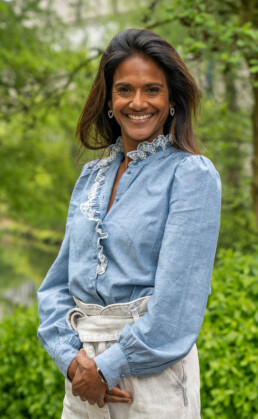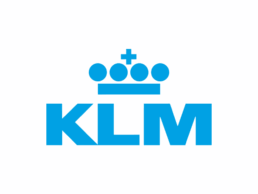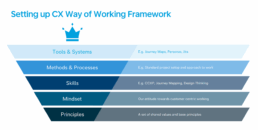Taking CX to New Heights: Jini Sankatsing's Customer-Centric Flightpath at KLM
Taking CX to New Heights:
Jini Sankatsing's Customer-Centric Flightpath at KLM
In a complex, global operation like KLM, embedding customer experience (CX) into the fabric of the organization is no small feat. Yet for Jini Sankatsing, Director of Customer Experience, it has been both her mission and her passion. With nearly two decades at the airline, Jini’s CX journey illustrates how structure, strategy, and people come together to shape consistent and memorable experiences.
Who is Jini?
Jini Sankatsing has been with KLM for 17 years, currently leading the Center of Excellence within the CX organization. Her team supports the broader CX function with setting the CX strategy, data-driven insights, service design capabilities, and a focus on desired customer centric employee behavior. Her roots in branding and marketing, combined with early experiences at Pearl Opticiens, sparked her passion for customer-centricity: "That was where I was first fully immersed in understanding customer needs, insights, and positioning."


Understanding the brand: KLM
KLM Royal Dutch Airlines is a major European airline known for its operational excellence, Dutch approachability, and global network. As part of the Air France KLM Group, KLM has built a strong CX foundation with a unique Dutch identity, balancing innovation with practicality and a warm, reliable service culture.
The challenge: From siloed optimization to integrated experience
Around 2015, KLM recognized that while many teams were doing great work individually, their siloed setup hindered the delivery of a seamless customer experience. Jini recalls, "No one was really looking at how it all came together for the customer. We were optimizing within the silos but neutralizing value overall."
It was during this period that KLM formally established its CX organization. A clear purpose was defined “Creating memorable experiences”, along with a desired customer experience that would guide the company forward. To support this transformation, governance platforms were created where all customer-related topics could be discussed and steered collectively across business units.
Additionally, post-COVID, she found that the organization had drifted back into fragmented ways of working. "Everyone was working hard, but we had lost sight of where we were heading. And everyone was doing CX in their own way." As Jini put it, "The moment we're inconsistent internally in how we approach CX, we can never deliver a consistent experience to our customers."
The solution: A two-fold transformation
When Jini rejoined the CX organization in 2021 after a period in operations, she defined two main goals: set a clear, long-term CX strategy and further professionalize the CX department.
- Anchoring strategy in purpose and data
She and her team revisited KLM’s customer promise, expanding the brand purpose to: Creating memorable experiences on the planet we care for. From that ambition, three differentiators were defined:
- Convenient connections: KLM takes me to my destination using their wide network and convenient hub
- Meaningful interactions: KLM genuinely cares about me, showing personal interest and helping me when needed
- Peace of mind: Customers have total control throughout their journey, they rely on KLM and know what to expect
Through portfolio management and data analysis, the Center of Excellence now prioritizes initiatives based on potential customer impact. Each year, high-level key results are defined, representing the strategic areas where KLM wants to make the biggest difference for its customers. Underneath these results, clear KPIs are formulated to monitor progress and impact.
Jini explains, “We break the elephant into pieces each year. We define high-level key results and work with the teams to translate them into actionable projects.” These projects are aligned per domain and are supported by detailed analysis to ensure they directly contribute to the overarching customer goals. Quarterly, the teams review progress using performance data to track which initiatives are on track, identify impediments, and decide where adjustments are needed to stay aligned with the strategy.
What Jini especially appreciates about her role is the full-circle involvement: “Even though we’re a supporting department, we are also steering the organisation. I love that we are there right from the beginning—defining which topics deserve attention—and also at the end, checking if we’ve actually achieved what we set out to do.”
- Building a shared CX way of working
The second pillar tackled inconsistency. Despite years of CX maturity, each team approached their work differently. Jini’s team co-created a framework with five core components:
- Processes & Methods: A shared development framework from startup to monitoring. This includes clearly defined phases such as startup, research, solutioning, testing, implementation, and monitoring. For each phase, the concrete steps, expected outcomes, and transition criteria to move to the next phase are documented.
- Tools & Systems: Clear overview of resources available and needed.
- Skills & Capabilities: Defined CX competencies and training needs.
- Mindset: A culture of ownership, challenge, and customer advocacy.
- Principles & Values: A shared belief system across CX teams.
Support by the Center of Excellence varies depending on complexity—from light guidance, to medium involvement, to heavy support for in-depth data consultancy or strategic initiatives.
To embed this way of working, an ambassador network was launched, assigning a CX Way of Working sponsor in every department. Next to that, continuous training is offered not only to Customer Journey Managers, but also to the management team. A highlight of this initiative was a two-day safari, where the full management team tackled a real-life CX case on hand luggage, applying the full CX methodology from research to solution.
To ensure the approach remains relevant and applied, best practices are regularly shared. After the initial kick-off, quarterly reviews are held where teams reflect on their use of the framework, exchange learnings, and identify phases where extra attention or support is needed.
Jini says, “We involved everyone within the CX organisation, from our EVP to customer journey managers. That was key to making it stick.” Their motto? “Tell me and I will forget. Show me and I may remember. Involve me and I will understand.”

Lessons learned & advice for CX professionals
Jini’s journey at KLM highlights several key insights:
- Strategic clarity matters: “You can’t execute without direction. The strategy gave us a common North Star.”
- Consistency enables quality: When teams adopt the same approach, it reduces variability, strengthens alignment, and ultimately enhances the quality and credibility of what customers experience.
- Let data guide the journey: From setting priorities to tracking progress, data keeps you focused on real impact.
- CX is everyone’s job: CX shouldn’t be seen as just a department—it’s a responsibility shared by everyone across the organization.
- CX at the boardroom table: The elevation of CX within KLM is reflected in the appointment of a Chief Experience Officer (CXO) in the board, ensuring that customer impact is considered in all top-level decisions.
- Co-creation is key: “Build it together, make it fun, and don’t overcomplicate it”—Jini’s philosophy shows that engagement and simplicity are vital for lasting CX adoption.
Final thoughts
With her dual focus on strategy and consistency, Jini has helped elevate CX at KLM from ambition to execution. Her team now operates as both starting point and endpoint: defining the direction, enabling the work, and measuring the results. In a turbulent industry, this structured yet human approach helps KLM stay true to its purpose— and to its customers, with staff who are proud to work for the airline.